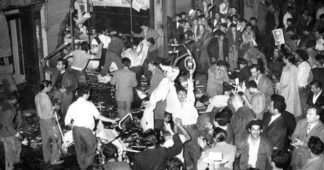Over the past 120 years, the Kishinev pogrom has become a myth that shaped Jewish consciousness forever. There is no child in Israel who has not heard about it. But The Kishinev riots are part of an ordinary day for people in Gaza
By Gideon Levy
“Arise and go now to the city of slaughter; / Into its courtyard wind thy way; / There with thine own hand touch, and with the eyes of thine head / Behold on tree, on stone, on fence, on mural clay / The spattered blood and dried brains of the dead.” (from “In the City of Slaughter,” Haim Nahman Bialik)
On Easter Sunday of 1903, riots against Jews broke out in Kishinev (today’s Chisinau, the capital of Moldova). The Russian press did not report it. The New York Times did, at length.
U.S. President Theodore Roosevelt met with a Jewish delegation in the wake of the riots and expressed deep sympathy for its victims. American newspapers published photographs of shroud-wrapped victims on the front page. The Russian term “pogrom” was born. Leo Tolstoy and Maxim Gorky denounced the riots and blamed the Russian government.
Future “national poet” Haim Nahman Bialik quickly wrote a short poem, “On the Slaughter,” and traveled from Odesa to Kishinev as part of a delegation organized by the historian Simon Dubnow. He stayed in the city for five weeks; he attended the trial of a handful of rioters who were sentenced to just a few years in prison and composed a list of the victims.
Upon his return, he published “In the City of Slaughter,” which Ze’ev Jabotinsky translated into Russian. Theodor Herzl prepared a plan for a Jewish homeland in East Africa, specifically in Uganda. Over the next 120 years, the Kishinev pogrom became a myth that shaped Jewish consciousness forever. There is no child in Israel who has not heard about it.
Bialik’s words in “On the Slaughter” – “A proper revenge for the blood of a little child / Satan has not yet devised” or “And if there is justice, let it show itself at once!” have been enshrined in the Hebrew language, always used to describe Jewish and Israeli victims.
The vicious pogrom lasted three days. It began on Easter Sunday, coinciding with the last day of Passover in the Diaspora, which, like this year, fell on April 19. Hundreds of Jewish homes were looted and destroyed. The local bishop blessed the rioters, who raped, threw babies out of high windows, drove nails into the heads of their victims and blinded them. Bialik discovered mangled limbs in a vegetable garden and a stable, which had become a human slaughterhouse.
Continue reading at archive.is
We remind our readers that publication of articles on our site does not mean that we agree with what is written. Our policy is to publish anything which we consider of interest, so as to assist our readers in forming their opinions. Sometimes we even publish articles with which we totally disagree, since we believe it is important for our readers to be informed on as wide a spectrum of views as possible.











